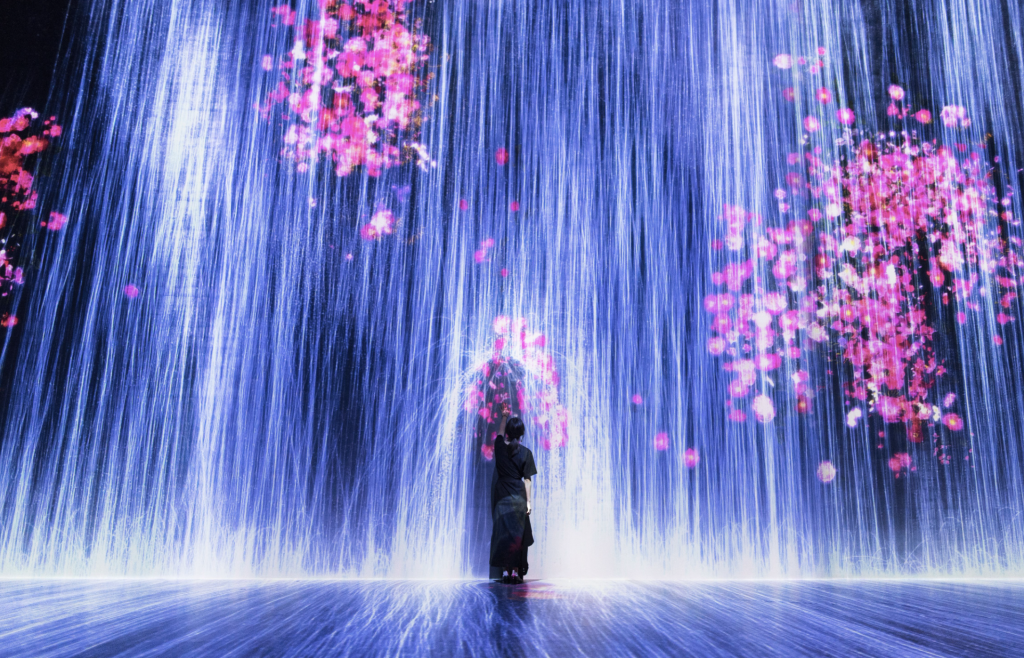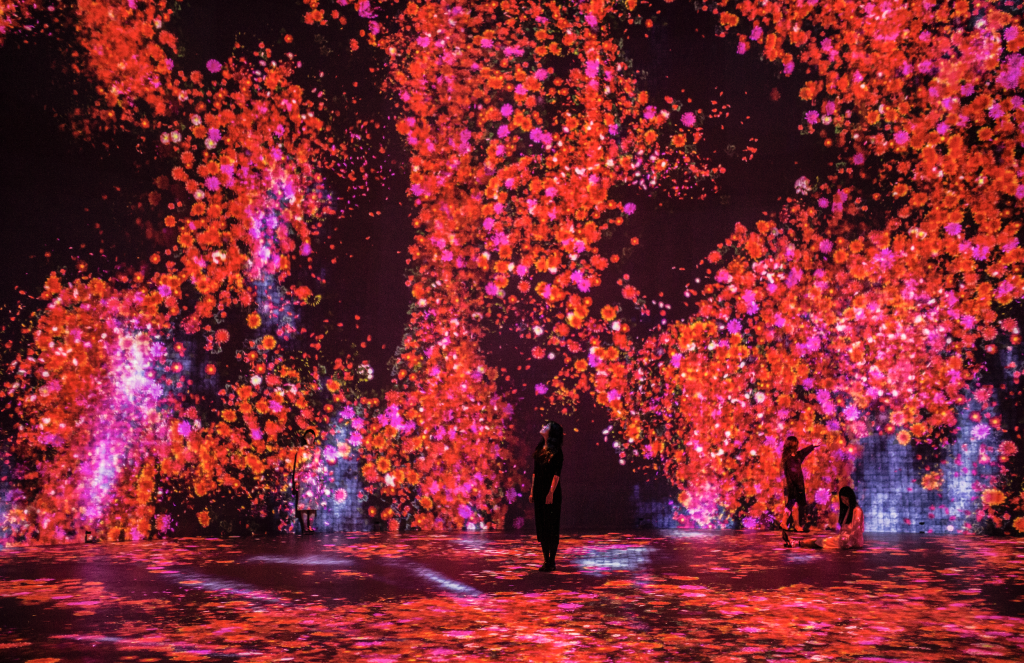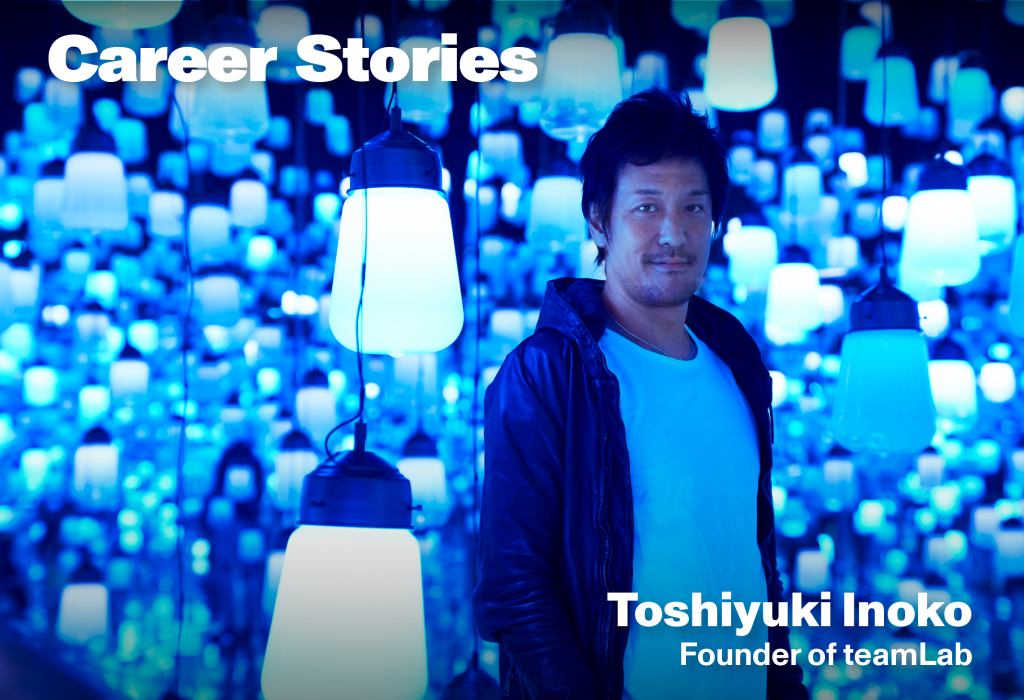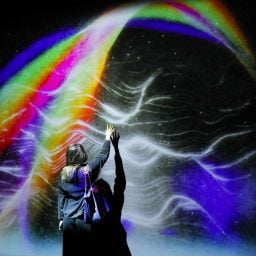From the time he was very young, teamLab co-founder Toshiyuki Inoko took pranking to another level. In one instance, he recalls rigging a floorboard at his school so that it spun when walked on, causing the walker to change direction. In another, Inoko transformed an entire classroom into an immersive experience using found wood and cardboard. He remembers his fellow students lining up by the hundreds, down hallways and stairwells, to see his room of tricks.
Today, Inoko’s work with the art collective teamLab has led to a similar series of long lines—albeit on a much bigger scale. Over the past 20 years, the group he founded has gone from presenting artworks on single monitors to employing a team of more than 600 people who create immersive digital worlds. Around the globe, people line up to experience the magic of teamLab.
They also pay up: teamLab charges fees for admission, a business model that makes them both a gallery-world disruptor and a fascinating example of the shift to a more experiential art world economy. In 2017, a three-location exhibition of their work through Pace drew an estimated 500,000 visitors, and over $10 million in ticket sales.
This year, teamLab is teaming up with Pace CEO Marc Glimcher once again. The collective is slated to present multiple immersive installations at Superblue, a new, 55,000-square-foot experiential art space in Miami headed up by Mollie Dent-Brocklehurst and Glimcher. As Superblue’s long-anticipated opening day approaches, we sat down with Inoko to hear about the early days of teamLab and how he became one of the world’s experiential-art powerhouses.

teamLab, Universe of Water Particles, Transcending Boundaries, 2017. © teamLab, courtesy Pace Gallery
What was your first project?
The first work for teamLab was in 2001. It was a collaboration artwork with a musician. While the musician was singing, people watching the live show could put a comment on the internet. We took these comments and displayed them inside the space, so the comments were floating all around. It was projected on the wall, and the comments eventually created the shape of a tree, kind of like an immersive space, with all of the comments floating.
At the time, making this first artwork was really, really hard because we didn’t have enough resources within the organization, and the technology was not that advanced. So once the technology advanced, it actually made it easier to do more complicated things. It sounds much easier than what we are doing right now, but it was actually quite difficult work.
Were there any projects that you thought of at the time, let’s say in 2001, that you weren’t able to execute because you didn’t have the technology?
What we were trying to do from the beginning is make artworks without any boundaries, capturing the scenery without any boundaries, like a lens. To do that, we found out people were actually moving around our exhibition space—even if we only had a monitor-based artwork. We found that people feel more free when they are looking at our artwork, that is why they are moving around our space. But when people are looking at pictures, or traditional sculptures, they just keep standing at one point, focusing on the one thing.
At the very beginning of teamLab, we usually had a small screen, not a big space, like now. Then, in 2004, we displayed artwork using five screens in a row. People could walk around in front of the artwork. But even with the five-channel display, it was finished in like 30 seconds.
At the time, it was too difficult to create an immersive space, like we are doing right now. It was really difficult to make a big space filled with artworks. But now, we can actually display everywhere, inside of museums as well.
How have you seen the landscape of digital art change over the course of your career?
This is not only for digital art, and not only for the art world, I feel it’s a trend for the entire world: People now are more interested in having experiences rather than owning something, like artwork. Usually, people buy a painting, sculpture, and then own it in their house or in a museum. But now, people’s interests are shifting from there to become more interested in having experiences. We also think it is more important that many people have the opportunity to experience artwork, rather than just limited people buying or owning artwork by themselves.
I think before, many people were interested in seeing very expensive artwork, but the actual price or the physical artwork itself would not have any meaning [to them] in the future. It is more important to give people a meaningful experience with artwork, not the [physical] artwork itself.

teamLab, Flowers and People, Cannot be Controlled but Live Together – Transcending Boundaries, A Whole Year per Hour, 2017. © teamLab, courtesy Pace Gallery
Can you buy teamLab’s art?
Sure, you can buy teamLab’s artwork. Actually, some museums have a teamLab collection. Honestly speaking, we believe giving a meaningful experience is much more important than having expensive artwork. But as you may know, the current art world is more traditional. As artists, we make some artwork that people can actually buy and own. But a majority of the artwork is too difficult to buy. We have a[n immersive] display at Superblue, but a monitor artwork can be displayed in a museum or at a home. So these kinds of things are available for the art market, but that is not what we really want to do. But as an artist in the current art world, we make some artwork available for the collectors and museums as well.
At the helm of teamLab, you manage hundreds of people every day. How do you balance the collaboration between so many people and executing your vision as an artist?
Everyone at teamLab knows I don’t do any management work. [Laughs] So I’m not balancing anything, I’m just focusing on what I want to make.
Could you break down your artistic process? How does it work with so many people involved?
That’s a good question. It’s difficult to have a clear answer for that because it’s always different. It’s actually difficult to say when the actual beginning of the creation is. Usually, at the very beginning, when I get an idea, I don’t have any clear goal. I’ll get some idea during a conversation with someone, then briefly start to do something with some other people, and so these kinds of seeds of the idea are everywhere. And then, sometimes, when the idea becomes more concrete, then we start to get more people who have actual skills to develop it further, focusing on making the idea into the artwork. But at the very beginning, when the idea is thought, we don’t have any clear goal usually. So the team gets bigger and bigger throughout the process.
How would you explain what you do to someone who has no idea how technology works?
I would say that I like to make things that change people’s perception.
Who are some of your inspirations as an artist?
I’m very interested in other artists’ works. I have visited many museums and exhibitions as well. I definitely get some inspiration from so many different artists, but there are no specific people I am influenced by. I really respect James Turrell, who is going to exhibit artwork here at Superblue with us as well.
Where do you see the future of digital interactive art experiences?
I don’t have a clear idea of what interactive digital art will be like in the future, but artwork itself will be shifting its value from ownership to giving an opportunity for many people to experience it. Before, artworks were supposed to be owned by a rich art collector or something. But, in the future, artworks should be, or could be, open for everyone to experience.
What is the best advice anyone has ever given you?
Generally, I do not listen to people. Not only for advice, just in general. [Laughs] Don’t listen too much. When I have an idea, and I explain it to other people, and other people say, “Oh, it’s awesome.” This kind of idea is usually good. But when I have a really good idea, and I explain it to other people, and their reaction is not really positive—in that case, this idea could be awesome.
This interview has been edited and condensed for clarity. Translation by Noriko Taniguchi.









